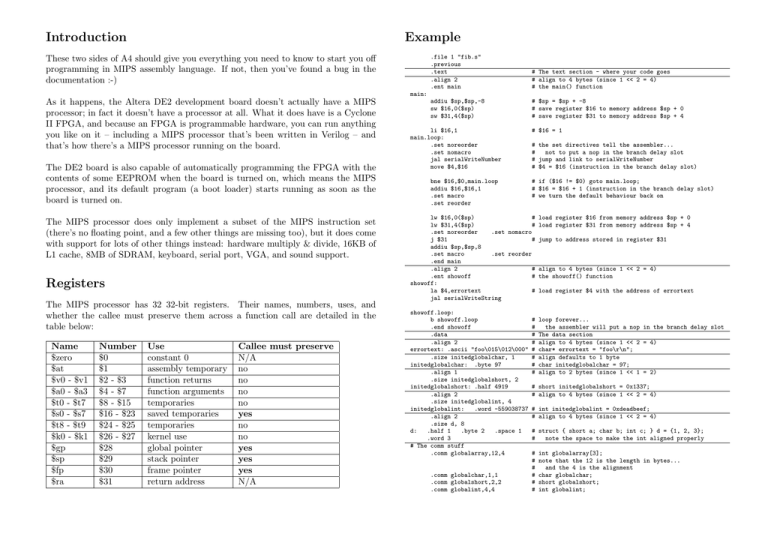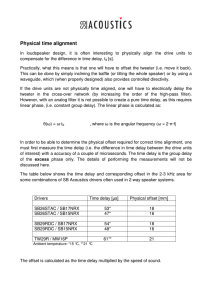Introduction Registers Example
advertisement

Introduction
Example
These two sides of A4 should give you everything you need to know to start you off
programming in MIPS assembly language. If not, then you’ve found a bug in the
documentation :-)
.file 1 "fib.s"
.previous
.text
.align 2
.ent main
# The text section - where your code goes
# align to 4 bytes (since 1 << 2 = 4)
# the main() function
addiu $sp,$sp,-8
sw $16,0($sp)
sw $31,4($sp)
# $sp = $sp + -8
# save register $16 to memory address $sp + 0
# save register $31 to memory address $sp + 4
main:
As it happens, the Altera DE2 development board doesn’t actually have a MIPS
processor; in fact it doesn’t have a processor at all. What it does have is a Cyclone
II FPGA, and because an FPGA is programmable hardware, you can run anything
you like on it – including a MIPS processor that’s been written in Verilog – and
that’s how there’s a MIPS processor running on the board.
The DE2 board is also capable of automatically programming the FPGA with the
contents of some EEPROM when the board is turned on, which means the MIPS
processor, and its default program (a boot loader) starts running as soon as the
board is turned on.
The MIPS processor does only implement a subset of the MIPS instruction set
(there’s no floating point, and a few other things are missing too), but it does come
with support for lots of other things instead: hardware multiply & divide, 16KB of
L1 cache, 8MB of SDRAM, keyboard, serial port, VGA, and sound support.
Registers
The MIPS processor has 32 32-bit registers. Their names, numbers, uses, and
whether the callee must preserve them across a function call are detailed in the
table below:
Name
$zero
$at
$v0 - $v1
$a0 - $a3
$t0 - $t7
$s0 - $s7
$t8 - $t9
$k0 - $k1
$gp
$sp
$fp
$ra
Number
$0
$1
$2 - $3
$4 - $7
$8 - $15
$16 - $23
$24 - $25
$26 - $27
$28
$29
$30
$31
Use
constant 0
assembly temporary
function returns
function arguments
temporaries
saved temporaries
temporaries
kernel use
global pointer
stack pointer
frame pointer
return address
Callee must preserve
N/A
no
no
no
no
yes
no
no
yes
yes
yes
N/A
li $16,1
main.loop:
.set noreorder
.set nomacro
jal serialWriteNumber
move $4,$16
bne $16,$0,main.loop
addiu $16,$16,1
.set macro
.set reorder
# $16 = 1
# the set directives tell the assembler...
#
not to put a nop in the branch delay slot
# jump and link to serialWriteNumber
# $4 = $16 (instruction in the branch delay slot)
# if ($16 != $0) goto main.loop;
# $16 = $16 + 1 (instruction in the branch delay slot)
# we turn the default behaviour back on
lw $16,0($sp)
# load register $16 from memory address $sp + 0
lw $31,4($sp)
# load register $31 from memory address $sp + 4
.set noreorder
.set nomacro
j $31
# jump to address stored in register $31
addiu $sp,$sp,8
.set macro
.set reorder
.end main
.align 2
# align to 4 bytes (since 1 << 2 = 4)
.ent showoff
# the showoff() function
showoff:
la $4,errortext
# load register $4 with the address of errortext
jal serialWriteString
showoff.loop:
b showoff.loop
.end showoff
.data
.align 2
errortext: .ascii "foo\015\012\000"
.size initedglobalchar, 1
initedglobalchar: .byte 97
.align 1
.size initedglobalshort, 2
initedglobalshort: .half 4919
.align 2
.size initedglobalint, 4
initedglobalint:
.word -559038737
.align 2
.size d, 8
d:
.half 1
.byte 2
.space 1
.word 3
# The comm stuff
.comm globalarray,12,4
.comm globalchar,1,1
.comm globalshort,2,2
.comm globalint,4,4
#
#
#
#
#
#
#
#
loop forever...
the assembler will put a nop in the branch delay slot
The data section
align to 4 bytes (since 1 << 2 = 4)
char* errortext = "foo\r\n";
align defaults to 1 byte
char initedglobalchar = 97;
align to 2 bytes (since 1 << 1 = 2)
# short initedglobalshort = 0x1337;
# align to 4 bytes (since 1 << 2 = 4)
# int initedglobalint = 0xdeadbeef;
# align to 4 bytes (since 1 << 2 = 4)
# struct { short a; char b; int c; } d = {1, 2, 3};
#
note the space to make the int aligned properly
#
#
#
#
#
#
int globalarray[3];
note that the 12 is the length in bytes...
and the 4 is the alignment
char globalchar;
short globalshort;
int globalint;
I-type instructions
instruction
addi $rt, $rs, imm
addiu $rt, $rs, imm
andi $rt, $rs, imm
beq $rs, $rt, label
bgez $rs, label
bgtz $rs, label
blez $rs, label
bltz $rs, label
bne $rs, $rt, label
lb $rt, label
lb $rt, label + offset
lb $rt, offset($rs)
lbu $rt, label
lbu $rt, label + offset
lbu $rt, offset($rs)
lh $rt, label
lh $rt, label + offset
lh $rt, offset($rs)
lhu $rt, label
lhu $rt, label + offset
lhu $rt, offset($rs)
lui $rt, imm
lw $rt, label
lw $rt, label + offset
lw $rt, offset($rs)
ori $rt, $rs, imm
sb $rt, label
sb $rt, label + offset
sb $rt, offset($rs)
sh $rt, label
sh $rt, label + offset
sh $rt, offset($rs)
sll $rd, $rt, sa
slt $rt, $rs, imm
sltu $rt, $rs, imm
sra $rd, $rt, sa
srl $rd, $rt, sa
sw $rt, label
sw $rt, label + offset
sw $rt, offset($rs)
xori $rt, $rs, imm
Pseudo instructions
detail
$rt = $rs + sign extend(imm)
$rt = $rs + sign extend(imm)
$rt = $rs & zero extend(imm)
if( $rs == $rt ) P C = label
if( $rs ≥ 0 ) P C = label
if( $rs > 0 ) P C = label
if( $rs ≤ 0 ) P C = label
if( $rs < 0 ) P C = label
if( $rs 6= $rt ) P C = label
$rt = sign extend(memory[label])
$rt = sign extend(memory[label + offset])
$rt = sign extend(memory[$rs + offset])
$rt = zero extend(memory[label])
$rt = zero extend(memory[label + offset])
$rt = zero extend(memory[$rs + offset])
$rt = sign extend(memory[label])
$rt = sign extend(memory[label + offset])
$rt = sign extend(memory[$rs + offset])
$rt = zero extend(memory[label])
$rt = zero extend(memory[label + offset])
$rt = zero extend(memory[$rs + offset])
$rt = imm << 16
$rt = memory[label]
$rt = memory[label + offset]
$rt = memory[$rs + offset]
$rt = $rs | zero extend(imm)
memory[label] = $rt
memory[label + offset] = $rt
memory[$rs + offset] = $rt
memory[label] = $rt
memory[label + offset] = $rt
memory[$rs + offset] = $rt
$rd = $rt << sa
$rt = $rs < sign extend(imm) ? 1 : 0
$rt = $rs < sign extend(imm) ? 1 : 0
$rd = $rt >> sa
$rd = $rt >>> sa
memory[label] = $rt
memory[label + offset] = $rt
memory[$rs + offset] = $rt
$rt = $rs ∧ zero extend(imm)
J-type instructions
instruction
j label
jal label
detail
P C = label
$31 = P C + 8; P C = label
limitations
−32768 ≤ imm ≤ 32767
0 ≤ imm ≤ 65535
the label must be
-32768 and 32767
instructions away
instruction in the
delay slot
between
inclusive
from the
branch
instruction
b label
bge $rs, $rt, label
bgeu $rs, $rt, label
bgt $rs, $rt, label
bgtu $rs, $rt, label
ble $rs, $rt, label
bleu $rs, $rt, label
blt $rs, $rt, label
bltu $rs, $rt, label
la $rt, label
li $rt, imm
move $rd, $rs
nop
detail
P C = label
if( $rs ≥ $rt
if( $rs ≥ $rt
if( $rs > $rt
if( $rs > $rt
if( $rs ≤ $rt
if( $rs ≤ $rt
if( $rs < $rt
if( $rs < $rt
$rt = label
$rt = imm
$rd = $rs
limitations
)
)
)
)
)
)
)
)
PC
PC
PC
PC
PC
PC
PC
PC
= label
= label
= label
= label
= label
= label
= label
= label
the label must be
-32768 and 32767
instructions away
instruction in the
delay slot
between
inclusive
from the
branch
R-type instructions
address % 2 = 0
address % 2 = 0
0 ≤ imm ≤ 65535
address % 4 = 0
0 ≤ imm ≤ 65535
0 ≤ sa ≤ 31
−32768 ≤ imm ≤ 32767
0 ≤ sa ≤ 31
0 ≤ imm ≤ 65535
instruction
add $rd, $rs, $rt
addu $rd, $rs, $rt
and $rd, $rs, $rt
div $rs, $rt
divu $rs, $rt
j $rs
jal $rs
mfhi $rd
mflo $rd
mthi $rs
mtlo $rs
mul $rd, $rs, $rt
mult $rs, $rt
multu $rs, $rt
nor $rd, $rs, $rt
or $rd, $rs, $rt
sll $rd, $rt, $rs
slt $rd, $rs, $rt
sltu $rd, $rs, $rt
sra $rd, $rt, $rs
srl $rd, $rt, $rs
sub $rd, $rs, $rt
subu $rd, $rs, $rt
xor $rd, $rs, $rt
detail
$rd = $rs + $rt
$rd = $rs + $rt
$rd = $rs & $rt
HI = $rt % $rt; LO = $rs / $rt
HI = $rt % $rt; LO = $rs / $rt
P C = $rs
$31 = P C + 8; P C = $rs
$rd = HI
$rd = LO
HI = $rs
LO = $rs
$rd = $rs ∗ $rt
HI = ($rs ∗ $rt) << 32; LO = $rs ∗ $rt
HI = ($rs ∗ $rt) << 32; LO = $rs ∗ $rt
$rd = !($rs | $rt)
$rd = $rs | $rt
$rd = $rt << $rs
$rd = $rs < $rt ? 1 : 0
$rd = $rs < $rt ? 1 : 0
$rd = $rt >> $rs
$rd = $rt >>> $rs
$rd = $rs − $rt
$rd = $rs − $rt
$rd = $rs ∧ $rt
limitations
Comments
limitations
All instructions treat the registers as signed integers (stored in two’s complement), unless they
end in ‘u’, in which case they treat the registers as unsigned integers.
The instruction following a branch or jump instruction is always executed, before the branch
or jump is actually taken.

